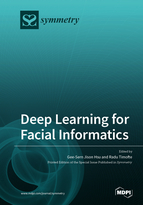Deep Learning for Facial Informatics
A special issue of Symmetry (ISSN 2073-8994). This special issue belongs to the section "Computer".
Deadline for manuscript submissions: closed (31 October 2018) | Viewed by 29571
Special Issue Editors
Interests: computer vision; pattern recognition
Special Issue Information
Dear Colleagues,
Deep learning has been revolutionizing many fields in computer vision, and facial informatics is one of the major fields. Novel approaches and performance breakthroughs are often reported on existing benchmarks. As the performances on existing benchmarks are close to saturation, larger and more challenging databases are being made and considered as new benchmarks, further pushing the advancement of the technologies. Considering face recognition, for example, the DeepFace and DeepID report nearly perfect and better-than-human performances on the LFW (Labeled Faces in the Wild) benchmark. More challenging benchmarks, e.g., the IARPA Janus Benchmark A (IJB-A) and MegaFace, are accepted as new standards for evaluating the performance of a new approach. Such an evolution is also seen in other branches of face informatics.
This special issue aims to delineate the state-of-the-art technologies in deep learning for facial informatics from multiple perspectives, including methods, architectures, databases, protocols and applications. Researchers from both academia and industry are cordially invited to share their latest advancements on all aspects of facial informatics. Both image- and video-based works are welcome. Topics for this special issue include, but are not limited to, the following: face recognition, face alignment, face detection and tracking, facial attributes (e.g., age, expression, gender, ethnicity, micro-expression, …), face hallucination, facial trait analysis.
All received submissions will be subject to peer review by experts in the field and will be evaluated based on their relevance to this special issue, level of novelty, significance of contribution, and the overall quality.
Prof. Gee-Sern Jison Hsu
Dr. Radu Timofte
Guest Editor
Manuscript Submission Information
Manuscripts should be submitted online at www.mdpi.com by registering and logging in to this website. Once you are registered, click here to go to the submission form. Manuscripts can be submitted until the deadline. All submissions that pass pre-check are peer-reviewed. Accepted papers will be published continuously in the journal (as soon as accepted) and will be listed together on the special issue website. Research articles, review articles as well as short communications are invited. For planned papers, a title and short abstract (about 100 words) can be sent to the Editorial Office for announcement on this website.
Submitted manuscripts should not have been published previously, nor be under consideration for publication elsewhere (except conference proceedings papers). All manuscripts are thoroughly refereed through a single-blind peer-review process. A guide for authors and other relevant information for submission of manuscripts is available on the Instructions for Authors page. Symmetry is an international peer-reviewed open access monthly journal published by MDPI.
Please visit the Instructions for Authors page before submitting a manuscript. The Article Processing Charge (APC) for publication in this open access journal is 2400 CHF (Swiss Francs). Submitted papers should be well formatted and use good English. Authors may use MDPI's English editing service prior to publication or during author revisions.
This charge will be waived for the top ranked 5 accepted submissions (therefore, no fee for the best papers).
For paper templates, please refer to https://www.mdpi.com/journal/symmetry/instructions.
DATES
Submission: October 31, 2018
First Review: November 31, 2018
First Revision Due: December 31, 2018
Final Review: January 10, 2019
Final Revision Due: January 20, 2019
Acceptance Notification: January 31, 2019
Online Publication: Right after acceptance
Keywords
- Deep Learning
- Computer Vision
- Face Recognition







